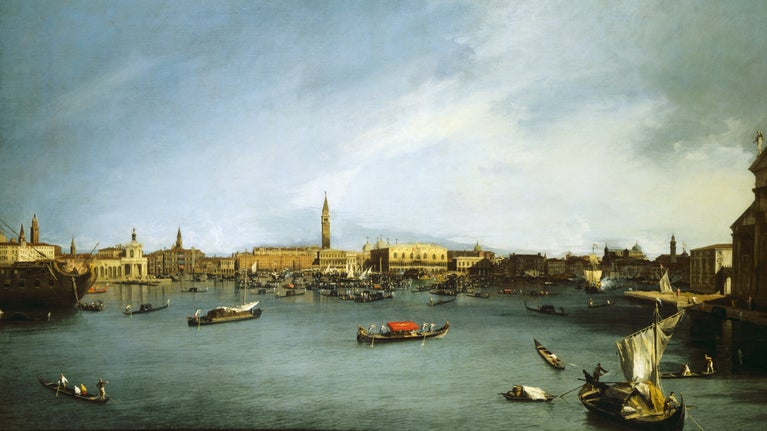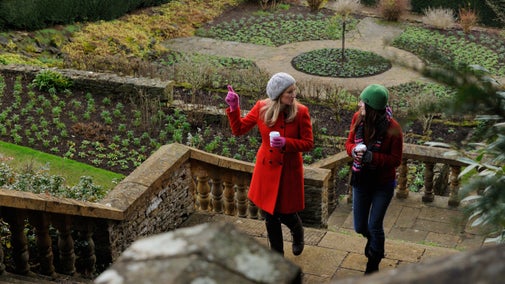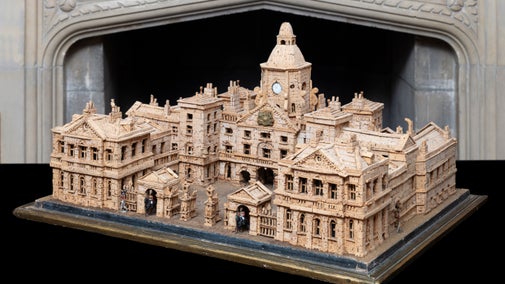
Upton's collections
Explore the objects and works of art we care for at Upton House on the National Trust Collections website.

Upton House is the country house and weekend retreat where 2nd Viscount Bearsted, Walter Samuel, assembled one of the finest art collections in 20th-century England. Immerse yourself in a remarkable range of world-class paintings, from Stubbs and Hogarth to Bosch and El Greco. See how Lord Bearsted furnished every square inch with his pictures and 18th-century English and French porcelain.
Upton House and Gardens was the beloved country home of the Jewish philanthropist, collector and Chairman of Shell, Walter Samuel, 2nd Viscount Bearsted and his family.
Remodelled in the 1930s as a weekend retreat, it had modern comforts, gardens and outstanding collections of paintings and porcelain.
While his greatest love was paintings, he also collected tapestries, illuminated manuscripts and oriental works of art, as well as early French and English porcelain, all of which are represented at Upton.
You can now delve deeper into the collection using the Smartify app. and discover more about the treasured art, porcelain and tapestries. Using the Smartify app on your mobile, take an audio tour with the Property Curator, dedicated volunteers and past family members who share their unique insights and stories. See the collection through a new lens with close-up images and more detailed information. You can find out more and share your feedback here.

The paintings cover a considerable range of masterpieces from Bruegel and Guardi to Hogarth and Stubbs, as well as a number of English sporting pictures.
It reflects Walter Samuel's interests in that almost all the pictures at Upton are concerned with human beings and their relationship with each other, as well as with the world around them.
The porcelain is 18th-century soft-paste Sèvres and Chelsea. Of special historic and artistic interest is the coffee can and saucer, made to royal order for Catherine the Great of Russia and the rare complete 10-figure Chelsea set of Apollo and the Nine Muses.
In the changed world after the Second World War, Walter Samuel, already in failing health, wanted to ensure that the collections and gardens he and his wife had created and loved were kept intact for others to enjoy for ever.
He decided to gift Upton House, the garden and the collections to the National Trust.
His generosity and philanthropy live on today every time visitors come to Upton House and enjoy the artwork he was so passionate about.
Jacopo Tintoretto’s The Parable of the Wise and Foolish Virgins is a rare and significant piece of Venetian art, now back on display after a detailed conservation project. Originally purchased by Upton’s former owner Lord Bearsted in 1939, the painting has long been admired for its vibrant colours and dramatic treatment of biblical themes, though it had been obscured over time by yellowed varnish and past restorations. The recent conservation work has revealed new insights into Tintoretto’s early artistic approach, with the painting’s original liveliness and intricate details now more visible than ever. Through various imaging techniques, such as x-ray and infrared reflectography, experts uncovered hidden layers, providing a deeper understanding of Tintoretto’s use of colour and composition.
In addition to the technical analysis, the conservation revealed fascinating details, such as the absence of scrolls in the Upton House version of the painting, which are present in a similar version held by the Bojmans Museum housed in Rotterdam. It remains uncertain whether this alteration was the artist's choice or the result of later intervention. Furthermore, changes to the balcony design, originally painted as stone but later transformed into cast iron, were also discovered, shedding light on the artist’s evolving creative process.
The Parable of the Wise and Foolish Virgins is now on display in the Sitting Room offering visitors the opportunity to appreciate Tintoretto’s work close up. There is detailed information about the painting’s conservation journey and the artist, and friendly volunteers will also be on hand to answer questions.
Take a closer look at one of Canaletto's impressive pieces, which is part of the Upton House art collection.
Canaletto is considered the most famous view-painter of the Georgian period. He was well known for his Venetian landscapes and attention to detail.
Giovanni Antonio Canal was born in 1697 in Venice. He was the son of Bernardo Canal, a successful painter of theatrical scenery. To distinguish himself from his father, he was given the nickname Canaletto, meaning 'a little canal'.
Inspiration for Canaletto's early painting came from established Venetian artists such as Marco Ricci and Luca Carlevarjis.
During his early career, Canaletto was taken under the wing of Joseph Smith, a merchant banker with contacts who was an ideal agent for the young artist.
By the end of the 1720s, most of Canaletto's paintings were commissioned through Smith. Smith also collected Canaletto’s work and commissioned him to paint six large views around San Marco and the Piazzetta to be displayed in his palace.
In addition, the collection had a series of 12 smaller views on the Grand Canal. These paintings were the most important pieces of Canaletto’s career.
In 1762, Smith was forced to part with his beloved Canaletto collection consisting of 50 paintings and 140 drawings. He sold them to George III who paid a staggering £20,000 for the collection. They were purchased to furnish the newly bought Buckingham House (later palace).
In the 1830s, the collection was moved to Windsor Castle where it has remained ever since.

During the Christmas period which starts 15 November, the Picture Gallery and Picture Gallery Passage are not open as part of the main visitor route. Conservation work takes place in these areas over the winter months. The decorations take centre stage in other areas of the house.
Looking ahead to visiting in January: during the quieter winter months, we take the opportunity to carry out conservation work in the house. Some rooms or spaces may be closed to allow for conservation and maintenance work. To give you more opportunities to visit and discover the collection, the house will remain open daily, some days will be free flow, others will be via guided visits.
On Tuesdays, Wednesday and Thursdays, the house will be open daily for guided visits only between 11.30am and 2.30pm. The guided visit will last for 40 minutes and will include light touch information about the house and collection, it is not a full tour. Guided visits will run every half an hour and no booking in advance is required, the tickets will be issued on a first come, first served basis at visitor reception upon arrival. The gardens, gift shop and café will be open daily (please see more detail under opening times) to help you plan your visit. There will be the option of level access guided visits at 12.30pm and 2pm on these days.
On Mondays and Fridays the house will be open between 11.30am - 3.30pm (last entry 3pm) free flow.
Please note: Upton houses an important collection of art and porcelain and it isn't possible to have all items on display permanently. To find out if a particular room or work is currently on display, on loan or in storage, please contact us before travelling.

Explore the objects and works of art we care for at Upton House on the National Trust Collections website.
Visit Upton's historic garden and marvel at the view that unfolds in front of you. Discover the Mirror Pool and views from the south lawn.

Discover more about the history of Upton House and how following its acquisition by Lord and Lady Bearsted in 1927, they set about improving the estate and hiring garden designer Kitty Lloyd-Jones to improve the garden.

Discover how a rare painting by Venetian artist Jacopo Tintoretto has been researched, and conserved in a detailed project.
Take a look at some of the conservation work that takes place at Upton to look after this place for everyone, for ever.

The art and heritage collections we care for rival the world’s greatest museums. Learn more about the collection of paintings, decorative art, costume, books, household and other objects at historic places.

Historic houses and buildings are full of stories, art and collections. Learn more about their past and plan your next visit.

Discover the historic houses and buildings around Warwickshire, from secluded forest houses to grand rural retreats from the Tudor and Victorian eras.
